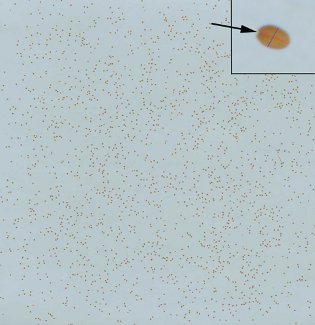Seed Size, Morphology, and Color
The process of quantifying seed size and shape begins with the digital imaging of groups of approximately 1000 seeds with a standard flatbed scanner using the grayscale setting at 3200 dpi.
The following is a representative image of an Arabidopsis seed population scan. The inset shows an enlargement of an individual seed with the major axis shown in red and the minor axis shown in blue. These and other morphometric parameters are automatically computed by custom software.

Applying this machine vision approach to the study of recombinant inbred lines developed for quantitative trait locus (QTL) mapping resulted in the characterization of the genetic architecture of seed size and shape traits. In separate studies, the relationships between seed properties and development of the emergent seedlings and the plants they became were also investigated by machine vision and image processing.
Publications
(2013) Mapping quantitative trait loci affecting Arabidopsis thaliana seed morphology features extracted computationally from images. G3: Genes, Genomes, Genetics 3: 109–118.
(2011) Separating parental environment from seed-size effects on next generation growth and development in Arabidopsis. Plant Cell & Environment 34, 291–301.
(2010) Plasticity of Arabidopsis root gravitropism throughout a multi-dimensional condition space quantified by automated image analysis. Plant Physiology 152, 206–216.